Facts about Kuwait:
The National Emblem:
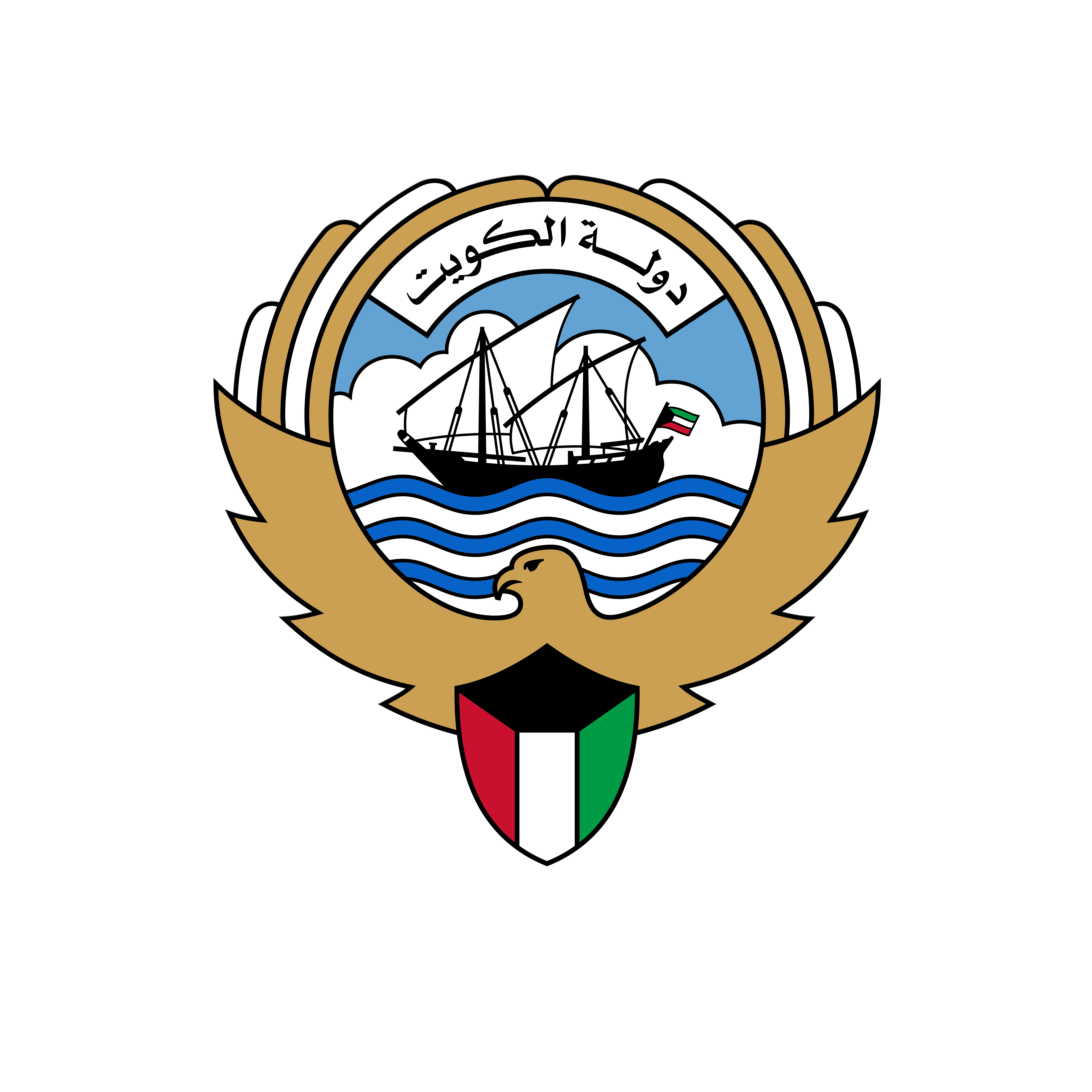 The emblem of Kuwait consisted of 'a helmet with a falcon and two intersecting flags over it' until the middle of 1963, when the Council of Ministers decided to replace it with a new one. The present emblem of Kuwait is a falcon with outspread wings embracing a dhow (boom) sailing on blue and white waves. It is a symbol of Kuwait’s maritime tradition.
The emblem of Kuwait consisted of 'a helmet with a falcon and two intersecting flags over it' until the middle of 1963, when the Council of Ministers decided to replace it with a new one. The present emblem of Kuwait is a falcon with outspread wings embracing a dhow (boom) sailing on blue and white waves. It is a symbol of Kuwait’s maritime tradition.
The First Flag of the State of Kuwait:
 After the conclusion of the Protectorate Treaty with the British Empire in 1899 and the declaration of the First World War, where Turkey and Britain were opponent parties, many discussions were carried on about the form of a new flag that would replace the Ottoman one. The situation deteriorated when the ship of a well-known Kuwaiti Trader raising the Ottoman flag was blocked by British boats that threatened the Kuwaiti ships of sinking them if they continued to raise the Ottoman flag, since there was a treaty between the two countries. Sheikh Mubarak Al-Sabah decided, then, to raise a new red flag with the word “Kuwait” in white. He also chose three forms of flag: a triangular flag for the Emirate, a square one for the public departments, and a rectangular one for the ships. The red flag underwent many changes until 1961.
After the conclusion of the Protectorate Treaty with the British Empire in 1899 and the declaration of the First World War, where Turkey and Britain were opponent parties, many discussions were carried on about the form of a new flag that would replace the Ottoman one. The situation deteriorated when the ship of a well-known Kuwaiti Trader raising the Ottoman flag was blocked by British boats that threatened the Kuwaiti ships of sinking them if they continued to raise the Ottoman flag, since there was a treaty between the two countries. Sheikh Mubarak Al-Sabah decided, then, to raise a new red flag with the word “Kuwait” in white. He also chose three forms of flag: a triangular flag for the Emirate, a square one for the public departments, and a rectangular one for the ships. The red flag underwent many changes until 1961.
The Current Flag Of Kuwait:
 When Kuwait gained full independence in 1961, the government decided to replace the old flag with a new design. This was promulgated by a law issued on September 7, 1961, some provisions of which were amended on November 18, 1961. The first Article stipulated that Kuwait’s national flag should consist of a horizontal rectangle which is twice as long as it is wide.
When Kuwait gained full independence in 1961, the government decided to replace the old flag with a new design. This was promulgated by a law issued on September 7, 1961, some provisions of which were amended on November 18, 1961. The first Article stipulated that Kuwait’s national flag should consist of a horizontal rectangle which is twice as long as it is wide.
This is divided into three equal horizontal stripes: the top one being green, the middle white and the bottom red; with the side next to the flag pole forming the base of a black trapezoid protruding into the stripes. The colors of the flag are derived from a poem by Safie Al-Deen Al-Hali.
The words of his poem denote:
White for our work
Black for our struggles
Green for our spring homes
Red for our past.
Over View:
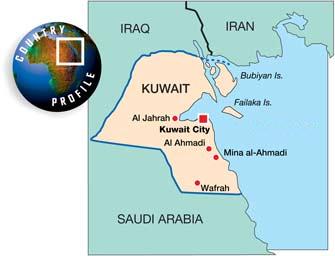
Since ancient times, Kuwait has served as the gateway to the Middle East because of its geographical location. Kuwait has drawn upon the accumulated wisdom of countries around the world to power its own growth. In a few decades, after the discovery of oil, a nation of fishermen and traders has transformed into one of the richest and developed nations in the world - offering state-of-the-art amenities, secure infrastructure and technical excellence - and is respected around the world.
The Kuwaitis' pride in their history, heritage and national progress has given rise to an identity which is uniquely Kuwaiti. An identity which is worthy of emulation by all nations in the world.
The centuries have changed; the traditions have not. The country has modernized, but its people's links with their heritage are as strong as ever. Kuwait's wealth -- Black Gold -- may be buried underground, but its spirit is still vibrantly free and alive.
National Anthem :
After the proclamation of Kuwait’s independence, the Kuwaiti national anthem was written by the poet Meshari Al-Adwani and was broadcast for the first time on February 25, 1978. The music was composed by Ibrahim Al-Soula and arranged by Ahmad Ali. The ‘Amiri Salute’ was composed by Yousuf Adees in 1951 and was used until February 1978. The ‘National Salute’ consists of the first six bars of the National Anthem.
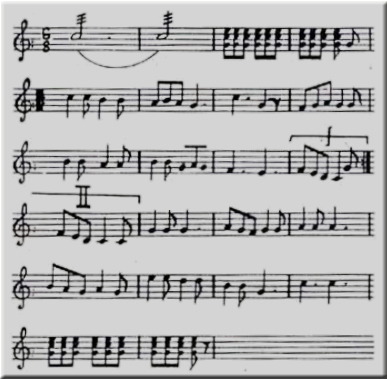
| The Words of the Anthem in Arabic |
Translated to English |
Watanil Kuwait Salemta Lilmajdi
Wa Ala Jabeenoka Tali-Ossadi
Watanil Kuwait
Watanil Kuwait
Watanil Kuwait Salemta Lilmajdi.
Ya Mahda Abaa-il Ola Katabou
Sefral Khloudi Fanadati Shohobo
Allaho Akbar Ehnahom Arabo
Talaat Kawakebo Jannatil Kholdi
Watanil Kuwait Salemta Lilmajdi.
Bourekta Ya Watanil Kuwaita Lana
Sakanan Wa Eshta Alal Mada Watana
Yafdeeka Horron Fi Hemaka Bana
Sarhol Hayati Be Akramil Aydi
Watanil Kuwait Salemta Lilmajdi.
Nahmeeka Ya Watani Wa Shahidona
Sharoul Hoda Wal Haqqo Ra-Edona
Wa Amirona Lil Ezzi Qa-Edona
Rabbol Hamiyati Sadqol Waadi
Watanil Kuwait Salemta Lilmajdi.
|
Kuwait, My Country, May you be safe and glorious May you always enjoy good fortune!
You are the cradle of my ancestors, who have distinguished themselves in this world, and immortalized themselves with their heroic deeds and martyrdom, and are to be found like stars shining in Paradise.
Kuwait, My Country, May you be safe and glorious! May you always enjoy good fortune! Kuwait,
My Country, May you be blessed as our happy homeland, and may you ever stand defended by free countrymen who have built our noble life with the most generous hands.
Kuwait, My Country, May you be safe and glorious! May you always enjoy good fortune!
We vow to defend you, with Divine Law as our witness, and truth and rightness as our guide, and with our reliable, generous and trustworthy Amir as our leader to prosperity and glory.
Kuwait, My Country, May you be safe and glorious! May you always enjoy good fortune!
|
Geography:
In the early 17th century Kuwait was known as Qurain (or Grane), from the Arabic words Qarn (a high hill) and Kout (a fortress). Some historians believe that Barrak Bin Ghuraif, Sheikh of the Bani Khalid tribe, built Kuwait in Grane and that since then the city has been referred to by its present name.
Location:
Kuwait lies at the north-west corner of the Arabian Gulf, between 28o and 30o latitudes and between 46o and 48o longitudes. To the north and the west, it shares a border of 240 km (149 miles) with the Republic of Iraq, and to the south and south-west it shares 250 km (155 miles) with the Kingdom of Saudi Arabia. On the east it has a coastline of 290 km (181 miles) on the Arabian Gulf.
Area and Topography:
The total area of the State of Kuwait is 17,818 sq km. Most of the mainland is a flat sandy desert gradually sloping towards sea level in the east. It is broken by shallow depressions and low hills, which form a ridge at Jal Al-Zor (145 meters above sea level), cut by the Umm Al-Ramam Wadi. The area is locally known as Ghodai, meaning a hill. The southern part of Kuwait is generally flat, with the exception of Ahmadi hill which is 137 meters above sea level.
The Kuwaiti mainland, with no mountains, rivers or other natural features, was for a long time a transit area for nomadic tribes and caravans. Such freedom of movement made delineation of borders rather difficult. On July 7, 1965, a neutral zone was created between the State of Kuwait and the Kingdom of Saudi Arabia. The northern part of the partitioned zone is administered by Kuwait, whilst the southern part is the administrative responsibility of Saudi Arabia. The crude oil extracted from the partitioned zone is equally shared by both countries.
Climate:
Due to the location of Kuwait in the Sahara geographical region, the weather of the country is characterized by long, hot and dry summers and short, warm and sometimes rainy winters. Dust storms almost always occur with a rise in humidity during summer.
The highest temperature ever recorded was 52oC in July 1978, (making Kuwait the fourth hottest place in the world). The lowest temperature, -6oC, was recorded in January 1964. There is a wide variation of temperature, ranging from an average of 45oC in summer to an average of 8oC in winter. Such climate fluctuation is often accompanied by a change in the annual rainfall -- which may vary from 22 mm one year to 352 mm the next.
Territorial Waters:
An Amiri Decree issued on December 17, 1967, defined the boundaries of Kuwait’s territorial waters as 12 miles -- for both the mainland and islands. It also regarded the Bay of Kuwait as purely inland waters, with the limits of territorial waters starting at the line between the two headlands of the little Gulf.
The area of Kuwaiti territorial waters is estimated at about 2,200 sq miles. They can be divided into two parts -- the shallow northern area, which is less than 5 meters deep in most places with a muddy bed, and the relatively deep southern area, which has a bed of sand and silica deposits. Most of Kuwait’s ports are located on the southern shore, taking advantage of the deep waters in this area.
The Coast:
There has always been a strong link between Kuwait and the sea, and it is this link which has shaped the distinctive character of today’s Kuwaitis and had constituted the main source of income in ancient times.
Although today the picture is very different with urban expansion and rapid modernisation, the link with the sea is still a cherished memory of the past for the Kuwaitis.
The 290-km coast can be divided into two main parts: one extending along the Arabian Gulf and the other around the Kuwaiti Bay and Khor Subiya. Most of the former area is characterized by sandy beaches, while the second area, 70 km in length, is characterized by mudflats, especially in the shallow northern area in the Bay of Kuwait where the maximum wave height is 16 cm opposite Kuwait city.
There are six seaports located at Shuwaikh, Doha, Ahmadi, Mina Abdallah, Shuaiba and Al-Zor, besides some special anchorage points used by companies and individuals. There are also 20 anchorage points for small boats. Eleven per cent of the beaches are assigned for tourist recreation and entertainment and 40 per cent of the shoreline is utilized by special establishments and nationals for private villas and chalets, whilst 35 per cent of the beaches, mainly in the northern part, are as yet pristine.
Flora:
Kuwait’s wild plant-life is one of its unique natural heritage. Plants are adapted to survive in the harsh conditions and extreme temperatures. Unfortunately, they suffered under the intense pressure caused by grazing, collection of fuel etc. However, four major ecosystems may be recognized, they are:
Sand-dune ecosystem:
Some perennial shrubs which have medicinal value grow here. The other dominant plantation is the annual grass.
Salt-marshes and saline depressions:
These are common along the shores of Kuwait. The plant-life here has to be more that just salt-tolerant since this is very much a marine dominated environment. A clearly defined zonation of plants associated with salt-marshes are found here.
Desert:
This is dominated by bushy clamps of perennial desert grass. However, in low depressions where occasional rainfall gathers, attractive purple or blue colored flowers grow aplenty.
Fauna:
Kuwait is home to numerous species of insects, animals and birds. Among the diverse insects the most attractive group is that of butterflies. Several beautiful varieties are found here and the best time to see them is Spring. There are 38 recorded reptiles in Kuwait, comprising of a variety of snakes, lizards, geckos etc. Besides, there are 50 listed varieties of mammals a number of them are endangered species. Some commonly found animals include hedgehog, wolf, wild cat, Gazelle etc. Nearly 280 species of birds have been recorded here. Incidentally, most of them are migratory birds.
Islands:
There are nine islands off the coast of Kuwait: Failaka, Bubiyan, Miskan, Warba, Auhha, Umm Al-Maradim, Umm Al-Naml, Kubbar and Qaruh.
Bubiyan, the largest island of the State, has an area of 863 sq km and is connected with the mainland by a concrete bridge. Warba, at the north extremity of the Gulf, occupies an area of 37 sq km. Miskan and Auhha lie on the north and the south of Failaka island, respectively. Located at the mouth of Kuwait Bay, a lot of Islamic antiquities have been found on Umm Al-Naml island. Kubbar and Qaruh lie at the southern end of the Gulf and have been the favorite homes for large flocks of sea birds.
Lying 20 km north-east of Kuwait city, the island of Failaka is the most beautiful and famous of Kuwait's islands. It combines the ancient history of Kuwait, dating back to the early Stone Age and the modern history of Kuwait, when the early Utubs settled in after their long journey, prior to their settlement on the Kuwaiti mainland in the late 17th century.
A 21-km submarine pipeline connecting the island to the mainland provides the inhabitants with more than 100 million gallons of sweet water every year. Parallel to the submarine water pipeline there are three submarine power cables from Kuwait City providing electrical energy to the island.
Failaka island has become a modern tourist attraction, keeping abreast of all aspects of modern progress. Every day, before the Iraqi aggression, visitors were carried from the mainland at Ras Al-Ardh (Salmiyah) to the island by ferry boats belonging to the Public Transport Company, to relax and swim in its lazuline waters. Much of their leisure time was spent at its five million sq meter tourist complex, located in the southern part of Failaka, which contains a good number of swimming pools, sports playgrounds and restaurants.
Kuwait's Currency:
 The first currency circulated in Kuwait discovered in Falaika Island was a Greek currency of the 3rd century before J. C. The Greeks lived in Falaika named at that time “Ikarus” and built houses, temples, and fortresses. The most important currency discovered was the one with the head of Alexander the Great and other currencies with the image of the King “Antakhus”, who governed the Island 200 years before J.C.
The first currency circulated in Kuwait discovered in Falaika Island was a Greek currency of the 3rd century before J. C. The Greeks lived in Falaika named at that time “Ikarus” and built houses, temples, and fortresses. The most important currency discovered was the one with the head of Alexander the Great and other currencies with the image of the King “Antakhus”, who governed the Island 200 years before J.C.
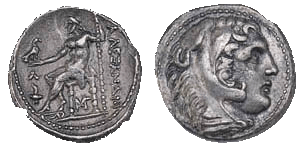 However, the first currency that circulated in Kuwait for 50 years was a strange coin (twisted metal) issued in Hassa before the foundation of the Emirate by the Sabah at the beginning of 18th century. From that time, other different currencies were used in Kuwait, as the Austrian real, the Indian Maher, Ottoman and Persian currencies. The entrance of the Indian currency, the Rupee, which circulated in Kuwait until 1960, was a consequence of the strong relationship in trade between Kuwait and Britain. In fact, the British Government decided to transfer the branch of the Agency of the East India Company from Basra to Kuwait in 1820, consequently Kuwait became the intermediary for British exportations from India to Europe.
However, the first currency that circulated in Kuwait for 50 years was a strange coin (twisted metal) issued in Hassa before the foundation of the Emirate by the Sabah at the beginning of 18th century. From that time, other different currencies were used in Kuwait, as the Austrian real, the Indian Maher, Ottoman and Persian currencies. The entrance of the Indian currency, the Rupee, which circulated in Kuwait until 1960, was a consequence of the strong relationship in trade between Kuwait and Britain. In fact, the British Government decided to transfer the branch of the Agency of the East India Company from Basra to Kuwait in 1820, consequently Kuwait became the intermediary for British exportations from India to Europe.
The Indian Rupee had known several phases:
- During the reign of William IV of England 1830-1837
- During the reign of Victoria of England 1837-1901
- During the reign of Edward VII of England 1901-1910
- During the reign of Georges V of England 1910-1936
- During the reign of Georges VI of England 1936-1952
- After the independence of India the Rupee was issued by the Indian Government with the Indian Emblem (A lion), it circulated in Kuwait since 1956.
- The Indian Government decided to replace the Indian Rupee that circulated in Kuwait and in the Golf Countries with a different one. This act had shocked all the Arab Golf Countries since the Indian Rupee had, at that time, a big effect on the economy. Consequently, the issuing of new currencies would have had bad effects not only on the Kuwaiti economy but also on the economies of other Arab Golf Countries.
Kuwait was obliged to accept the procedure undertaken by the Indian government but Sheikh Abdullah Al-Salem Al-Sabah ordered the Financial Department to take the necessary steps to issue a national Kuwaiti currency.
Sheikh Abdullah Bin Sabah Bin Jaber Al-Sabah, the fifth governor of Kuwait (1866-1892), had tried before to issue a hand made Kuwaiti currency but the coins were not uniform and they were far from being competitive with Indian and English currencies, especially because Kuwait did not have the necessary gold cover.
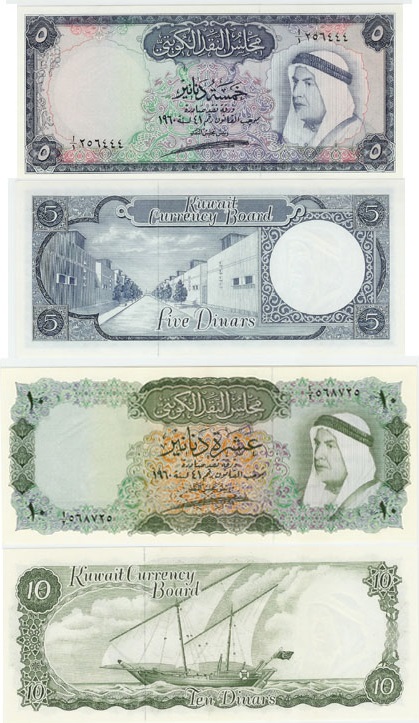 In April 1961, the First issue of the Kuwaiti Currency, the Kuwaiti Dinar, was put into circulation replacing the “Indian Rupee”. The Kuwait currency comes with denominations Quarter Dinar, Half Dinar, One Dinar, Five Dinars, ten Dinars, Twenty Dinars.
In April 1961, the First issue of the Kuwaiti Currency, the Kuwaiti Dinar, was put into circulation replacing the “Indian Rupee”. The Kuwait currency comes with denominations Quarter Dinar, Half Dinar, One Dinar, Five Dinars, ten Dinars, Twenty Dinars.
Since the beginning of placing the Kuwait Currency in circulation, there have been five consecutive issues of the Kuwaiti Currency. The Fifth one is the only currently circulating currency of the State of Kuwait with a high-level technology utilizing technical features and security developments. As far as the coins are concerned, no changes have so far been made since the day it was issued in 1961. The units of these coins are, One Fils, Five Fils, Ten Fils, Twenty Fils, Fifty Fils, and One Hundred Fils. These coins have retained their designed technical specifications since inception.